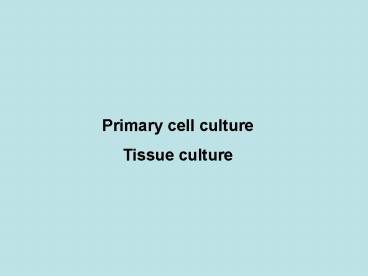Primary cell culture PowerPoint PPT Presentation
1 / 15
Title: Primary cell culture
1
Primary cell culture Tissue culture
2
Brief theory Principles of Biosafety
Introduction to the Primary Cell Culture
Practical Protocols Reagents and Techniques
for Cell Culture
3
Why primary?
The growth of cells taken directly form the
living organism (e.g. biopsy material) is also
known as primary cell culture. The culture
consists of mixed population of cell types.
Frequently, some of the cells may survive
without proliferating and will therefore be lost
in the increasing population of those which are
able to multiply in the conditions supplied in
vitro. Many of the cells will only survive for
one or a few passages before dying (Terminal
differentiation Senescence cells)
Cells may sometimes be converted to cell lines by
passage or induction. These may continue to
proliferate for a number of cell generations. In
some instances the primary cells are fused with
so-called immortal (cancer) cells to produce a
hybridoma line.
4
Certain special considerations when using human
tissue 1-consent forms and confidentiality
2-biohazard potential , viruses, . (For
example, it needs individual tank)
5
Connective tissue
Sources of Connective tissue Forms the dermis
of the skin Capsules and stroma of various
organs Mucous and serous membranes Cartilage,
bone, tendons, ligaments, adipose tissue
6
Connective tissues made of cells and
extracellular fibers Cells Fibroblasts
Lymphocytes Adipocytes Monocytes Neutrophils
Macrophages Fibers Collagen Reticular Elastic
7
Collagen -major component -rod like fibers
-protein is triple helical polypeptide
-extensive crosslinking -resistant to
hydrolytic attack by many proteases -attack with
a mix of enzymes Collagenase
Hyaluronidase Pronase Elastase
8
Epithelial tissue
Sources of Epithelial tissue Epidermis Glands
of the skin (sweat, sebaceous) 0uter corneal
layer Lining of digestive and reproductive
tracts Endothelium Parts of liver, pancreas,
pituitary, gastric and intestinal glands
Types of intracellular attachment Zona
occludens Zona adherens Macula adherens
(desmosomes) Points digestive enzymes can break
these (collagenase, trypsin, hyaluronidase)
chelating agents enhance activity - deplete Ca
9
The things that you should know before starting
to work with primary cell culture and suitability
of material for doing Primary Culture Types of
tissue Species of origin Age of the individual
(animal or human) Dissociation medium used
Enzymes used Enzyme concentration and purity
Temperature Incubation Time The reason for the
culture Suplements
10
Practical order 1. Isolation of tissue 2.
Dissection and/or disaggregating cells migrate
out from small tissue chunks in flask
disaggregating either mechanically or
enzymatically create cell suspension some
cells will adhere to substrate in culture 3.
Culture in flasks
11
ISOLATION
Common points of tissue isolation 1-Remove fat
or necrotic tissue should be removed 2-Chop
tissue finely with sharp instrument (minimize
damage) 3-Remove desegregation enzymes by
centrifugation 4-Higher conc. of cell needed for
primary isolation than subculturing 5-Use
richest medium possible 6-Embryonic tissue is
best (disaggregates better, get more viable
cells, proliferates better) - ES or AS cell
culture is primary cell culture
12
Dissection and/or disaggregating can be done in
three methods
A- Explants Points 1-original method developed
at turn of the century 2-finely chop tissue to
very small parts 3-cells migrate away from
pieces onto culture flask 4-useful with small
tissue samples (biopsies) 5-slow process,
certain cells migrate faster than others
(fibroblasts)
B- Mechanical Disaggregation Points 1-vigorous
pipetting 2-pressing tissue into a mesh 3-wash
cells through sieve 4-faster than enzymes but
less yield 5-causes mechanical damage to cells
13
C- Disaggregating by Enzymatic
action Points 1-need to disrupt cell-cell
adhesion proteins 2-crude preparations of
enzymes are often used 3-may contain other
proteases as contaminants (work better)
3-purified mixtures are less damaging to cells
though 4-cells can be damaged to point of lysis
Enzymes (Strongest to Weakest) Trypsinaction Pa
pain Elastase Hyaluronidase Collagenase Type
II Collagenase Type I Collagenase Type
IV Collagenase Type III DNase
14
Removal of Fibroblasts -Considered as a
contaminating cell -Proliferate rapidly -Use
monoclonal antibody -Thy-1 found on human
fibroblasts but not on other cells -Will target
fibroblasts for destruction or removal -Also
add supplements to media Cholera toxin 10nM
Cis-hydroxy proline 10ug/ml
15
Troubleshooting Yield and Viability Issues
Low Yield and Low Viability Under or over
dissociation Have cellular damage Solution
use less harmful digestive enzyme (trypsin to
collagenase) decrease concentration of enzyme
Low Yield and High Viability Under dissociation
Solution first, increase concentration of
enzyme or increase incubation time next, use
other enzyme or combinations
High Yield and Low Viability Good dissociation
Have cellular damage (enzyme too strong)
Solution Reduce enzyme concentration /or
Reduce incubation time /or Dilute enzyme with
BSA or soy proteins Goal increase viability w/o
changing yield
High Yield and High Viability Good dissociation
Good yield

